Tri-Faith Initiative
Posted: August 23, 2015 Filed under: Uncategorized Leave a commentTri-Faith Initiative
SLIDE 3: COUNTRYSIDE JOINS TRI-FAITH INITIATIVE
 In April I noted on Facebook that my home church, Countryside Community United Church of Christ in Omaha, had voted to join the Tri-Faith Initiative in Omaha, Nebraska. As I read about this innovative and courageous interfaith project I became excited. In a world where religious fundamentalists of all flavors are demonizing all faiths other than their own, where political candidates are criticizing the President because he will not use the term “Islamic Terrorist,” thus alienating almost one billion people, we are in need of an experiment that proves that people of different faiths can live and work together in peace and harmony.
In April I noted on Facebook that my home church, Countryside Community United Church of Christ in Omaha, had voted to join the Tri-Faith Initiative in Omaha, Nebraska. As I read about this innovative and courageous interfaith project I became excited. In a world where religious fundamentalists of all flavors are demonizing all faiths other than their own, where political candidates are criticizing the President because he will not use the term “Islamic Terrorist,” thus alienating almost one billion people, we are in need of an experiment that proves that people of different faiths can live and work together in peace and harmony.
SLIDE 4: TEMPLE ISRAEL LONG HISTORY OF INTERFAITH LEADERSHIP
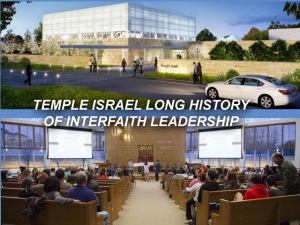 The Tri-Faith Initiative in Omaha is comprised of Temple Israel, the oldest synagogue in Nebraska, the American Muslim Institute one of five mosques in Omaha, and now Countryside Community United Church of Christ. The beginnings of interfaith cooperation are written deep in Omaha’s past. Temple Israel has been a community leader for 144 years. I remember as a teenager growing up at Countryside Church we held all of our youth group retreats at Camp Esther K. Newman, the Jewish Community Center Camp, where we were joined in our activities and discussions by “Uncle” Sherman Poska an important leader in the Jewish Community and a member of Temple Israel. Rabbi Brooks from Temple Israel and Bob Alward the Pastor at Countryside enjoyed a good working relationship, and so part of our confirmation was a tour of Temple Israel and an introduction to Judaism by the Rabbi.
The Tri-Faith Initiative in Omaha is comprised of Temple Israel, the oldest synagogue in Nebraska, the American Muslim Institute one of five mosques in Omaha, and now Countryside Community United Church of Christ. The beginnings of interfaith cooperation are written deep in Omaha’s past. Temple Israel has been a community leader for 144 years. I remember as a teenager growing up at Countryside Church we held all of our youth group retreats at Camp Esther K. Newman, the Jewish Community Center Camp, where we were joined in our activities and discussions by “Uncle” Sherman Poska an important leader in the Jewish Community and a member of Temple Israel. Rabbi Brooks from Temple Israel and Bob Alward the Pastor at Countryside enjoyed a good working relationship, and so part of our confirmation was a tour of Temple Israel and an introduction to Judaism by the Rabbi.
SLIDE 5: A MINISTER AND A RABBI WALKED INTO A BAR
 Rabbi Aryeh Azriel, leader of Temple Israel since 1988 has continued the work of interfaith cooperation and justice work of his predecessors. Rabbi Azriel and Dr. Eric Elnes the pastor of Countryside Community Church jointly led a study group two years ago entitled “A Minister and a Rabbi Walked into a Bar.” The study was held in a bar and they packed the place for six weeks running.
Rabbi Aryeh Azriel, leader of Temple Israel since 1988 has continued the work of interfaith cooperation and justice work of his predecessors. Rabbi Azriel and Dr. Eric Elnes the pastor of Countryside Community Church jointly led a study group two years ago entitled “A Minister and a Rabbi Walked into a Bar.” The study was held in a bar and they packed the place for six weeks running.
SLIDE 6: AMERICAN MUSLIM INSTITUTE – DR. SYED MOHIUDDIN
 The Muslim community in the Tri-Faith Initiative is the American Muslim Institute. I spoke on the telephone with the President of the mosque Dr. Syed Mohiuddin, who confirmed that when I was growing up in Omaha the Muslim population was very, very small. In recent years, however, like many other Mid-west Cities the Muslim population has grown very fast, so there are now five Mosques in Omaha. The American Muslim Institute welcomes all people and bridges the divide between Sunni and Shiite and many different ethnic groups. The relationship between the American Muslim Institute and Temple Israel was cemented, when the day after 9/11, Rabbi Azriel showed up at the American Muslim Institute to help protect the Mosque from any angry backlash. This gesture of courage and compassion led the way for a ground breaking interfaith relationship. And that led to a rather mundane conversation about parking and building space.
The Muslim community in the Tri-Faith Initiative is the American Muslim Institute. I spoke on the telephone with the President of the mosque Dr. Syed Mohiuddin, who confirmed that when I was growing up in Omaha the Muslim population was very, very small. In recent years, however, like many other Mid-west Cities the Muslim population has grown very fast, so there are now five Mosques in Omaha. The American Muslim Institute welcomes all people and bridges the divide between Sunni and Shiite and many different ethnic groups. The relationship between the American Muslim Institute and Temple Israel was cemented, when the day after 9/11, Rabbi Azriel showed up at the American Muslim Institute to help protect the Mosque from any angry backlash. This gesture of courage and compassion led the way for a ground breaking interfaith relationship. And that led to a rather mundane conversation about parking and building space.
SLIDE 7: SHARED VALUES AND COMMITMENT TO INTERFAITH COOPERATION
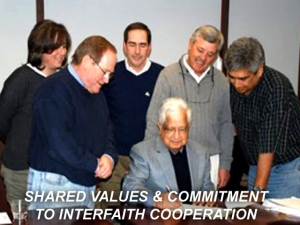 Temple Israel had outgrown its building and as they were thinking about a new location they wanted to have good neighbors. And so a conversation began between the leaders of Temple Israel and the leaders of Omaha’s Muslim community about both groups’ land and parking needs. The two groups then started talking about their shared values and commitment to interfaith work, and they expressed their mutual desire to foster hope for their children and for future generations; they recognized themselves as two Abrahamic faith groups. The conversations gave birth to an unlikely dream: wouldn’t it be remarkable if three Abrahamic faiths could partner to build three houses of worship on adjacent properties? They began looking for a Christian church that might also share the dream.
Temple Israel had outgrown its building and as they were thinking about a new location they wanted to have good neighbors. And so a conversation began between the leaders of Temple Israel and the leaders of Omaha’s Muslim community about both groups’ land and parking needs. The two groups then started talking about their shared values and commitment to interfaith work, and they expressed their mutual desire to foster hope for their children and for future generations; they recognized themselves as two Abrahamic faith groups. The conversations gave birth to an unlikely dream: wouldn’t it be remarkable if three Abrahamic faiths could partner to build three houses of worship on adjacent properties? They began looking for a Christian church that might also share the dream.
SLIDE 8: HONEST CONVERSATIONS
 Many interfaith projects start with a long “getting to know you” period that focuses on what the faith groups have in common. But the Omaha group did things differently than the norm; they came together to build a tangible project and they talked about their greatest fears right away. Everyone had tough questions and concerns. How would they keep their unique faith identities? Who would own and control the buildings? And perhaps, the greatest fear — that members of one faith group would try to convert members of the other groups. As they worked out their questions, the delegates developed a Memorandum of Understanding that stands as the framework for collaboration today. More importantly, the honest conversations led to a deep sense of trust and respect among the delegates. Real relationships were growing, and that had become the most important thing.
Many interfaith projects start with a long “getting to know you” period that focuses on what the faith groups have in common. But the Omaha group did things differently than the norm; they came together to build a tangible project and they talked about their greatest fears right away. Everyone had tough questions and concerns. How would they keep their unique faith identities? Who would own and control the buildings? And perhaps, the greatest fear — that members of one faith group would try to convert members of the other groups. As they worked out their questions, the delegates developed a Memorandum of Understanding that stands as the framework for collaboration today. More importantly, the honest conversations led to a deep sense of trust and respect among the delegates. Real relationships were growing, and that had become the most important thing.
SLIDE 9: CHALLENGE STEREOTYPES
 A memorandum of agreement was developed. Here are some of the important elements of that memorandum:
A memorandum of agreement was developed. Here are some of the important elements of that memorandum:
In working together, our vision is to build bridges of respect, trust and acceptance, to challenge stereotypes of each other, to learn from one another, and to counter the influence of extremists and agents of hate.
SLIDE 10: RESPECT — NO PROSELYTIZING
 Each participant community’s religious building/space will be completely separate and controlled only by that group. Each participant community agrees to completely respect the beliefs and practices of the other participants. All beliefs shall be respected. To the extent practices take place outside the walls of one’s own religious space, consideration shall be given to the beliefs of other participants. No participant community shall engage in any proselytizing (intending to convert members of other participant communities).
Each participant community’s religious building/space will be completely separate and controlled only by that group. Each participant community agrees to completely respect the beliefs and practices of the other participants. All beliefs shall be respected. To the extent practices take place outside the walls of one’s own religious space, consideration shall be given to the beliefs of other participants. No participant community shall engage in any proselytizing (intending to convert members of other participant communities).
SLIDE 11: SHARED SPACE
 To the extent each participant community can agree to do so, they will create ‘shared space’ that will allow for efficiencies of common operation and facilitate collaboration and interaction between and among the participants. This is expected to include such basic things as parking and common outdoor areas. It is hoped to include such things as shared library space, food service, meeting rooms, auditorium, conference and banquet facilities and other common indoor areas.
To the extent each participant community can agree to do so, they will create ‘shared space’ that will allow for efficiencies of common operation and facilitate collaboration and interaction between and among the participants. This is expected to include such basic things as parking and common outdoor areas. It is hoped to include such things as shared library space, food service, meeting rooms, auditorium, conference and banquet facilities and other common indoor areas.
SLIDE 12: ACCEPTANCE, RESPECT, TRUST BUILDING
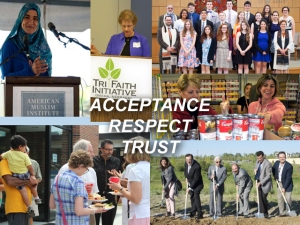 Participant communities shall foster among their members an environment of acceptance, respect and trust-building towards other participants and their members. Participant communities agree to seek and create opportunities for communities, groups, families and individuals to gather, meet, interact and learn about and from one another. Participant communities shall look for opportunities to understand differences and build on commonalities among participants.
Participant communities shall foster among their members an environment of acceptance, respect and trust-building towards other participants and their members. Participant communities agree to seek and create opportunities for communities, groups, families and individuals to gather, meet, interact and learn about and from one another. Participant communities shall look for opportunities to understand differences and build on commonalities among participants.
SLIDE 13: GREATEST CHALLENGE FINDING A CHURCH
 The greatest challenge was finding a Church to participate in the project. The Episcopal Diocese of Nebraska started out in the conversations, but they were unable to find a congregation, who could enter into the agreement. Finally in 2013, the Episcopalians invited Countryside Church to become the Christian presence in the Tri-Faith Initiative. In April of 2015 the congregation of Countryside Community Church United Church of Christ finally voted to participate in the Tri-Faith Initiative.
The greatest challenge was finding a Church to participate in the project. The Episcopal Diocese of Nebraska started out in the conversations, but they were unable to find a congregation, who could enter into the agreement. Finally in 2013, the Episcopalians invited Countryside Church to become the Christian presence in the Tri-Faith Initiative. In April of 2015 the congregation of Countryside Community Church United Church of Christ finally voted to participate in the Tri-Faith Initiative.
SLIDE 14: GROUND BREAKING
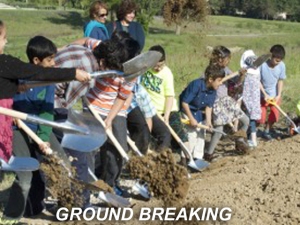 Temple Israel has already built their building on the shared site. The American Muslim Institute broke ground for their building on May 21st of 2015. Countryside is still in a study phase before launching a building campaign.
Temple Israel has already built their building on the shared site. The American Muslim Institute broke ground for their building on May 21st of 2015. Countryside is still in a study phase before launching a building campaign.
SLIDE 15: ALL CHILDREN OF THE SAME GOD
 Now why have I chosen to preach about the Tri-Faith Initiative? First, Temple Israel, the American Muslim Institute and Countryside Church have decided to recognize that they are all children of the same God. Now just as in families each child has a different relationship with their parent, they are none the less brothers and sisters in the same family – all God’s children.
Now why have I chosen to preach about the Tri-Faith Initiative? First, Temple Israel, the American Muslim Institute and Countryside Church have decided to recognize that they are all children of the same God. Now just as in families each child has a different relationship with their parent, they are none the less brothers and sisters in the same family – all God’s children.
SLIDE 16: LIVING INTO A DIFFERENT ATTITUDE
 Second, we are living in a dangerous world where radicals of all religious stripes are trying to tell us that we cannot trust people of other faiths and indeed we must be aggressive and hostile toward other faiths seeking to convert others who believe or behave differently from us. This kind of aggressive and hostile attitude often leads to violence toward others who are different from ourselves. The Tri-Faith initiative is trying to live into a different attitude where mutual respect and understanding are the hallmark of relationship. If we can prove to the world that we can live together in peace even affirming one another’s faith, we can begin to change our world. As the memorandum of understanding reads: In working together, our vision is to build bridges of respect, trust and acceptance, to challenge stereotypes of each other, to learn from one another, and to counter the influence of extremists and agents of hate.
Second, we are living in a dangerous world where radicals of all religious stripes are trying to tell us that we cannot trust people of other faiths and indeed we must be aggressive and hostile toward other faiths seeking to convert others who believe or behave differently from us. This kind of aggressive and hostile attitude often leads to violence toward others who are different from ourselves. The Tri-Faith initiative is trying to live into a different attitude where mutual respect and understanding are the hallmark of relationship. If we can prove to the world that we can live together in peace even affirming one another’s faith, we can begin to change our world. As the memorandum of understanding reads: In working together, our vision is to build bridges of respect, trust and acceptance, to challenge stereotypes of each other, to learn from one another, and to counter the influence of extremists and agents of hate.
SLIDE 17: CAPTURING THE HIGHEST VALUES OF THE ABRAHAMIC TRADITION
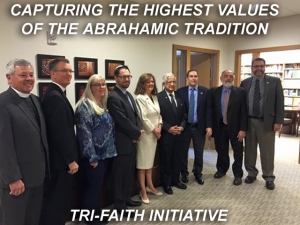 As one member of the American Muslim Institute wrote about the Tri-Faith Initiative: “This project also captures the highest values we are called to in the Abrahamic tradition. Those of mutual respect, service and scholarship. When the world is so full of conflict and cruelty between members of the Abrahamic faiths, this initiative stands as a shining example of what is possible when people practice their faith — instead of perverting it.”
As one member of the American Muslim Institute wrote about the Tri-Faith Initiative: “This project also captures the highest values we are called to in the Abrahamic tradition. Those of mutual respect, service and scholarship. When the world is so full of conflict and cruelty between members of the Abrahamic faiths, this initiative stands as a shining example of what is possible when people practice their faith — instead of perverting it.”
SLIDE 18: HUNTSVILLE RIPE FOR A MULTI-FAITH INITIATIVE
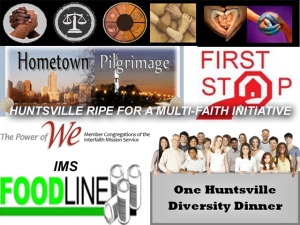 Third, I believe as a result of the ground work laid by the Interfaith Mission Service Huntsville has the potential to take bold steps toward a multi-faith initiative. I don’t know what that initiative might look like, but I believe we have the potential here in our community to make a significant contribution to interfaith relationships.
Third, I believe as a result of the ground work laid by the Interfaith Mission Service Huntsville has the potential to take bold steps toward a multi-faith initiative. I don’t know what that initiative might look like, but I believe we have the potential here in our community to make a significant contribution to interfaith relationships.
SLIDE 19: BABY STEPS VISIT THE MOSQUE
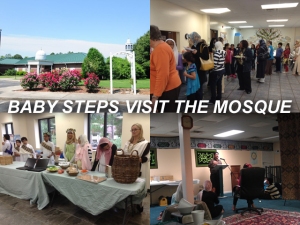 Fourth since all journeys begin with baby steps I would like to affirm Alix Morehouse’s suggestion that we at United Church can arrange a tour of a mosque here in Huntsville for our Sunday school children and any adults who would like to accompany them. We can help our children and members realize that Muslims are people just like us. The extremists in the Muslim world are a very small minority, just as we have Christian extremists.
Fourth since all journeys begin with baby steps I would like to affirm Alix Morehouse’s suggestion that we at United Church can arrange a tour of a mosque here in Huntsville for our Sunday school children and any adults who would like to accompany them. We can help our children and members realize that Muslims are people just like us. The extremists in the Muslim world are a very small minority, just as we have Christian extremists.
SLIDE 20: RADICAL HOSPITALITY AWAITS US
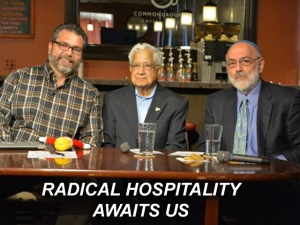 Fifth, when I spoke with Dr. Mohiuddin, Rabbi Azriel and Dr. Elnes they all promised that if a group from Huntsville would like to make a pilgrimage to Omaha to see and experience the Tri-Faith Initiative we would receive radical hospitality. I want to share this sermon with the other members of the Southeast Clergy Cluster and others to test whether we might organize a group from Huntsville to journey to Omaha and perhaps strengthen our own resolve to further our interfaith relations.
Fifth, when I spoke with Dr. Mohiuddin, Rabbi Azriel and Dr. Elnes they all promised that if a group from Huntsville would like to make a pilgrimage to Omaha to see and experience the Tri-Faith Initiative we would receive radical hospitality. I want to share this sermon with the other members of the Southeast Clergy Cluster and others to test whether we might organize a group from Huntsville to journey to Omaha and perhaps strengthen our own resolve to further our interfaith relations.
SLIDE 21: GOD IS OUR BELOVED – PEACE, SHOLOM, SALAAM
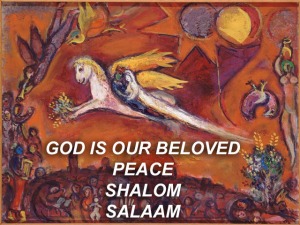 God is our beloved. Now if we can just learn to love all of the other beloveds of God, perhaps we can live together in peace – Shalom – Salaam.
God is our beloved. Now if we can just learn to love all of the other beloveds of God, perhaps we can live together in peace – Shalom – Salaam.
Recent Comments